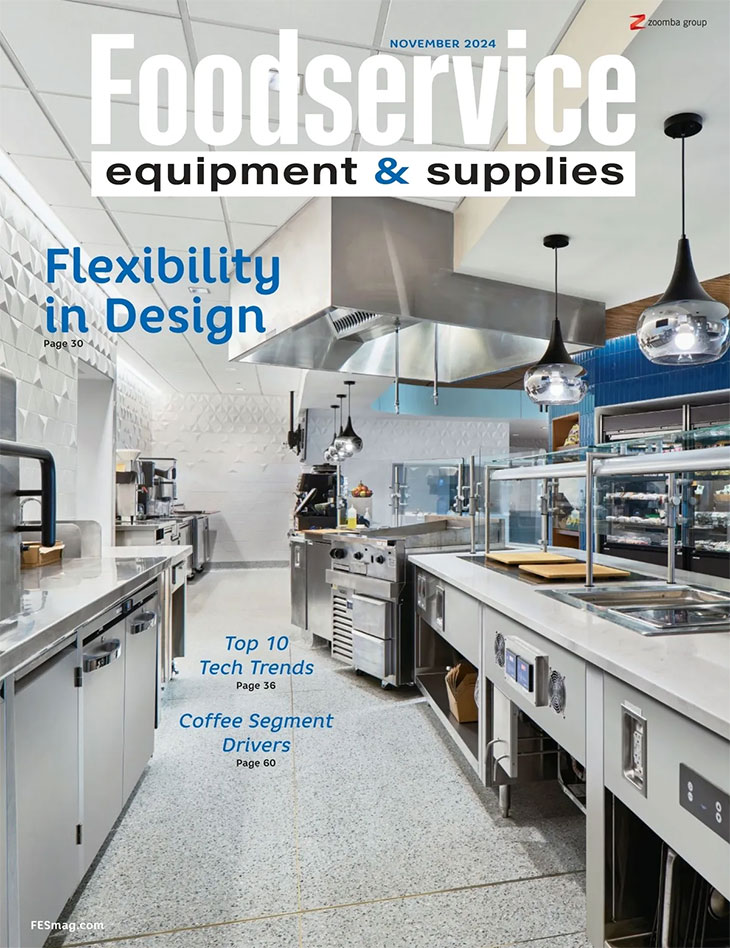Local health codes govern the number of kitchen sinks, which in turn impact the amount of faucets a foodservice operation requires. The number of faucets necessary also depends on the size of a kitchen. A typical quick-service operation will have seven faucets, including two prerinse types and three hand sinks. Faucets are specified separate from sinks.
 This category includes traditional faucet types and prerinse units, with subcategories that encompass pot fillers, glass fillers, utility sprays and hose reels. The application will impact the type of faucet necessary. Handwashing faucets use a lower water flow compared with, for example, a faucet that fills pots, which requires greater flow.
This category includes traditional faucet types and prerinse units, with subcategories that encompass pot fillers, glass fillers, utility sprays and hose reels. The application will impact the type of faucet necessary. Handwashing faucets use a lower water flow compared with, for example, a faucet that fills pots, which requires greater flow.
Commercial faucets come in ½- and ¾-inch sizes, which match up with the water line size. While ½-inch are more common, ¾-inch faucets do not have a flow restrictor. This means that when these faucets’ valves open, they use the full water line. The ¾-inch faucets can use up to 40 gallons of water per minute. Operators commonly use these larger faucets for big scullery sinks where staff wash large sheet pans. The ¾-inch type also helps fill 40- to 60-gallon steam-jacketed kettles.
By comparison, ½-inch faucets are the same size as residential types. These may have a ½- to 2.2-gallon-per-minute aerator on the end, which acts as a flow restrictor. Foodservice operators commonly use ½-inch faucets with 3-compartment sinks, bathroom or handwashing sinks, and dipper wells.
Prerinse units use the most water, and the units’ aerator determines the flow rate. This type offers different spray heads with various flow rates ranging from 0.5 gpm to 1.6 gpm.
Larger sinks and those with two, three or four compartments will typically have more than one faucet, one with a longer neck or a prerinse unit. Operators can also opt to use combinations of different faucet types.
Configurations include backsplash mount, deck mount and adjustable wall mount. Deck-mounted faucets attach through a hole in the rim of the sink, while backsplash-mounted types attach at a 90-degree angle. Other configurations include deck-mounted single pantry style and double pantry style faucets. Commercial faucets install on 8- or 4-inch centers or in a single hole, depending on the sink and application. Faucet spouts can swivel or remain rigid; can be single, double-jointed or gooseneck; and can have spout-end control valves for wok-style ranges and pot fillers.
Faucets also come with a variety of options, such as extra T connections, swivel spray valves, vandal-resistant aerators and antimicrobial aerators.
The Reduction of Lead in Drinking Water Act was signed into federal law in January 2011, and full compliance was required by January 2014. The law requires a 0.25 percent maximum lead content, measured through a weighted average, for all pipes, fixtures and fittings sold in the U.S. for installations delivering water for human consumption. As a result, commercial faucets generally feature lead-free, heavy-duty forged brass construction.
Operators can choose one, two or no handles. While operators often use two handles for handwashing and warewashing sinks, they generally use single handles in conjunction with kettles, braising pans, Chinese ranges and other foodservice equipment utilizing water. To help avoid cross-contamination at handwashing sinks, consider hands-free faucets, which operate with an electronic sensor.
To operate more sustainably, foodservice operations incorporate low-flow faucets in kitchen hand sinks and bathrooms to conserve water. Hands-free or electronic faucets can also save water since these work in timed 10- to 15-second intervals, which tend to be shorter than the average handwashing time of a minute.











